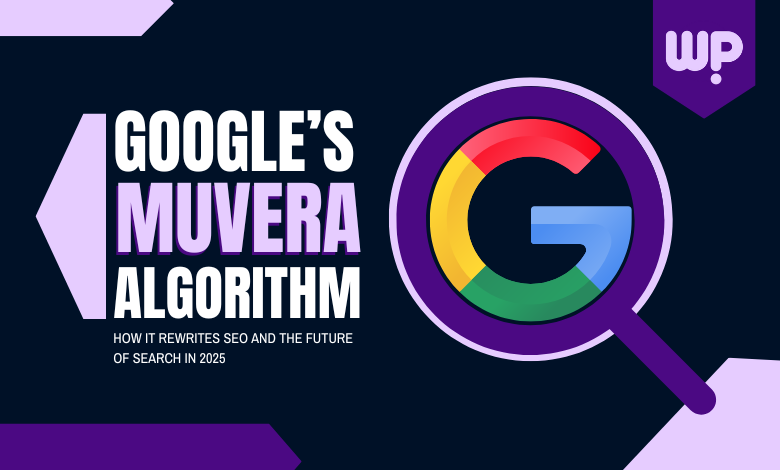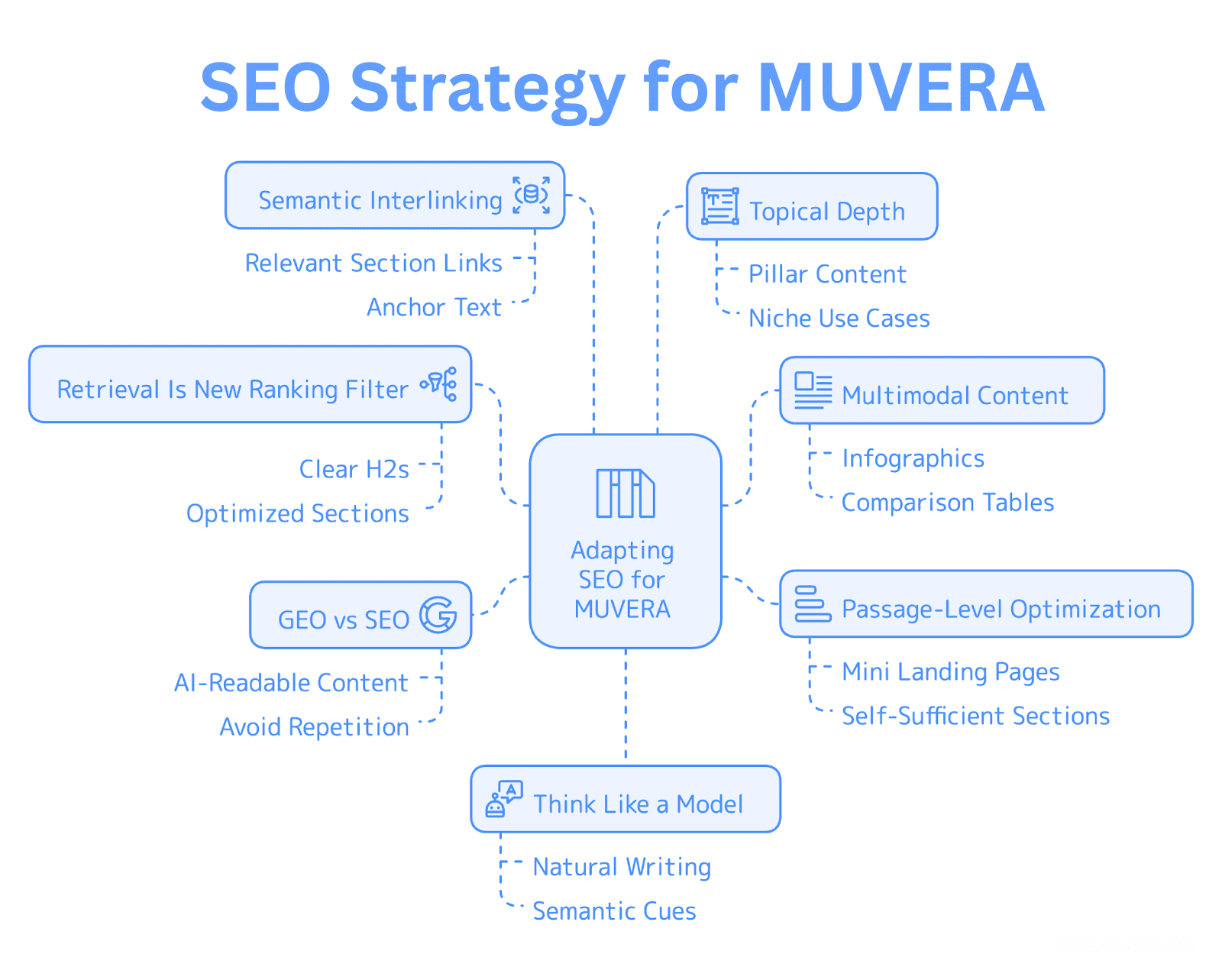Google’s MUVERA Algorithm: How It Rewrites SEO and the Future of Search in 2025

Google has always aimed to make search more intuitive, helpful, and human-like. With the introduction of the MUVERA algorithm in 2025, that vision has taken a massive leap forward. MUVERA isn’t just another update—it’s a foundational shift in how Google understands search queries, evaluates content, and delivers results. If you’re a digital marketer, SEO professional, or business owner, understanding MUVERA is no longer optional—it’s essential.
In short, Google’s MUVERA Algorithm has redefined what relevance and efficiency mean in the world of digital information.
What Is MUVERA? The Algorithm Redefining Search in 2025
MUVERA stands for Multi-Vector Encoding via Random Aggregation. This is a sophisticated algorithm that revolutionizes how search engines understand and match the intent behind search queries with web content. Instead of analyzing language piece by piece, MUVERA encodes the entire meaning of a query into a single, dense vector. This vector holds the full semantic and contextual meaning, allowing Google to match the query more accurately with web content.
Earlier algorithms like BERT and MUM processed queries using multiple vectors and multi-step models. While these approaches brought major improvements in understanding context and meaning, they required heavy computational power and time. MUVERA solves this by compressing the essence of a query or a document into a Fixed-Dimensional Encoding (FDE), significantly speeding up the entire retrieval process.
What makes this important? It allows Google to process complex queries faster and more effectively. Whether someone searches for “best protein sources for vegans who work out daily” or “how to remove mold without harsh chemicals,” MUVERA can grasp the user’s true intent and return deeply relevant content in a fraction of the time.
MUVERA is Google’s most human-like approach to understanding information yet. — Leading SEO Thought Leader
MUVERA’s Breakthroughs: Fixed-Dimensional Encodings & Chamfer Scoring
MUVERA isn’t just a technical improvement—it’s a complete rethinking of search mechanics. Two standout features make this possible:
- Fixed-Dimensional Encodings (FDEs): These are compact, singular vector representations that encapsulate the full meaning of a search or document, making search results faster and more accurate.
- Chamfer Similarity Scoring: Once the initial results are retrieved, MUVERA applies this method to deeply compare and re-rank results based on how semantically close they are to the original intent.
Together, these changes help Google sift through billions of documents in milliseconds and deliver only the most relevant results.
SEO in the MUVERA Era: Why Keyword Stuffing Is Officially Dead
The MUVERA algorithm demands a new way of thinking about content creation and optimization. Keyword stuffing, thin content, and disjointed blog posts no longer stand a chance. Instead, success now depends on how well your content reflects real user intent.
Content must now be written with the searcher’s goals and questions in mind. This means writing naturally, answering complete queries, and creating content that fits into a larger topic ecosystem.
For example, writing an article titled “10 Quick Recipes” without adding context like dietary goals, time-saving tips, or meal-planning suggestions is unlikely to perform well. MUVERA favors depth, clarity, and real value.
How MUVERA Works: The Two-Phase Process Behind Lightning-Fast Searches
The core innovation lies in MUVERA’s two-phase process. First, documents and queries are converted into their own fixed-dimensional encodings—a single semantic vector that captures multiple meanings. This allows for ultra-efficient scanning across massive indexes. Second, the top-scoring candidates undergo a deeper multi-vector re-ranking, where each token embedding is compared to ensure precision of meaning.
The impact is powerful: search results remain rich and context-aware, while performance becomes almost instantaneous. MUVERA delivers near real-time semantic intelligence, overcoming the speed barriers of older multi-vector systems.
To break it down:
- Initial Query Processing: MUVERA takes the search input and encodes it into a single vector using FDE. This vector holds contextual, emotional, and logical information.
- Document Matching: It retrieves documents that are most aligned with the encoded vector. These are not just based on words but on meaning.
- Re-Ranking: The top results are then ranked using Chamfer Similarity, which refines the ranking based on even more precise semantic alignment.
This means Google is no longer just matching keywords—it’s matching purpose and usefulness.
MUVERA vs. BERT & MUM: Why This Isn’t Just Another Update
MUVERA builds on BERT’s sentence-level understanding and MUM’s multimodal capabilities but introduces speed and scale previously unseen. BERT could understand context within a sentence but struggled with speed. MUM allowed for richer understanding but was computationally expensive. MUVERA combines the best of both worlds.
A simple comparison:
| System | Representation | Strength | Limitation |
| Single‑vector | One embedding per item | Extremely fast | Limited in understanding complexity |
| Multi‑vector | Many embeddings/token | Highly precise semantic matches | Too slow and resource-intensive |
| MUVERA | Combined FDE + re-rank | Smooth blend of speed and depth | Requires semantically rich content |
MUVERA effectively collapses the performance-accuracy trade-off. It retains semantic depth without sacrificing speed, ushering in a new era for search responsiveness.
The June 2025 Core Update: How MUVERA Rewrote the Ranking Rules
MUVERA was deployed as part of the June 2025 Core Update. It caused significant shifts in search rankings. Sites that prioritized in-depth, well-structured, and helpful content rose in rankings. Websites depending on outdated SEO tactics saw drops.
This update emphasized:
- Content depth and completeness
- Author expertise and transparency
- Technical performance like loading speed and mobile usability
E-E-A-T became more critical, especially in health, finance, and safety-related content.
Google Ads + MUVERA: How AI Max Leverages Intent for Smarter Campaigns
The launch of AI Max in Google Ads around the same time as MUVERA leveraged the new understanding of user intent. This match type doesn’t rely on keyword matches but instead looks at what the user is really looking for.
An ad campaign about allergy relief might now show for a query like “how to sleep better during spring” if MUVERA deems it contextually appropriate.
This changes how marketers approach ad copy, audience targeting, and keyword research. AI Tools for Agencies are now integrating MUVERA-ready content strategies to ensure their campaigns align seamlessly with user intent.
Local SEO Under MUVERA: Hyper-Relevant Results for Nearby Searches
For local businesses, MUVERA enhances Google’s ability to understand localized intent. A search for “best vegan brunch spot open now near 5th Avenue” will return more accurate results that consider:
- The user’s real-time location
- Current business hours
- Menu availability and reviews
Businesses should focus on keeping Google Business Profiles updated, implementing structured data, and ensuring website speed and mobile optimization.
Redefining SEO Strategy for MUVERA
Post-MUVERA SEO is strategic and user-centric. Strategies that now perform well include:
- Content Hubs: Organize content into clusters around a central topic. This helps Google understand authority and depth.
- Intent-Based Writing: Know the why behind a search query and craft content to meet that need.
- UX-Driven SEO: A site that loads quickly, is mobile-friendly, and easy to navigate is more likely to be rewarded—not just for rankings, but for improved online visibility across search channels.
- Content Structure: Proper use of headers, internal linking, and table of contents helps both users and search crawlers.
Voice Search Optimization: Why Natural Language Wins with MUVERA
Voice queries tend to be longer and more natural, and MUVERA is built to handle them well. Users are now more likely to get precise answers from conversational queries like, “How can I treat a sore throat naturally at home?”
Optimizing for voice search includes writing in natural language, using structured data, and creating FAQ sections with clear answers.
Zero-Click Searches Rise: How to Dominate SERPs Without Clicks
As MUVERA improves answer quality directly in SERPs, zero-click searches increase. While it might seem like a threat, it’s actually an opportunity. Being featured in a zero-click result builds authority.
To leverage this:
- Provide direct, high-quality answers at the top of your content.
- Use schema for FAQs and How-To sections.
Link Building Post-MUVERA: Why Topical Authority Beats Domain Authority
Link-building must now focus on topical alignment. A link from a niche site that shares your subject matter is more valuable than a link from a generic high-domain-authority site.
Internal linking also gains strength—linking semantically related articles within your site boosts contextual understanding.
Beyond SEO: How MUVERA Accelerates Answer Engine Optimization (AEO)
SEO is evolving into AEO, where the goal is to become the best answer, not just the highest-ranking result. MUVERA accelerates this shift by favoring content that truly answers user questions.
Success now depends on:
- Rich media like videos, infographics, and interactive tools
- Clear, accessible writing
- Deep coverage of the topic from multiple angles
Expert Insights
Search is no longer about matching words—it’s about matching meaning. — Anonymous Google AI Researcher
Top FAQs About Google’s MUVERA Algorithm
1. What is MUVERA’s main advantage?
Its ability to combine deep contextual understanding with lightning-fast result delivery through single-vector encoding.
2. How does MUVERA change SEO content writing?
Writers must now focus on natural language, intent matching, and informational depth instead of keyword density.
3. Can MUVERA interpret multimedia content?
Yes, although not to the extent of MUM, it is designed to work well with multimodal content when enhanced with proper metadata.
4. Should I re-optimize all old content?
You should audit older content for intent alignment, semantic depth, and technical health to stay competitive.
5. How do I know if my site is MUVERA-ready?
Evaluate your site’s performance in terms of loading speed, structured content, topical authority, and user engagement.
6. How does MUVERA affect long-tail keywords?
It enhances their value. Long-tail keywords often signal specific intent, which MUVERA is designed to understand.
7. Is structured data more critical now?
Yes. Structured data allows MUVERA to better understand the function and context of your content.
8. How does MUVERA influence bounce rates?
Better-matched search results mean users find what they want faster, reducing bounce rates for quality content.
9. What should local businesses focus on under MUVERA?
Real-time updates to their Google Business Profile, structured data implementation, and intent-matching content.
10. How does MUVERA impact ecommerce SEO?
Product pages must now be context-rich, with detailed descriptions, customer reviews, and intent-driven content for higher visibility.
Final Insight
MUVERA isn’t a minor update—it’s a seismic shift. Searching becomes faster and more intuitive. Rankings will favor clarity, intent-based narratives, and technical excellence. Organizations that embrace empathy, structure, and optimization across devices will rise to the top. For SEO and marketing, the future belongs to those who treat users and algorithms as partners in an evolving conversation.
If you’d like case studies, implementation guides, or personalized rollout plans, I’d be happy to help!







